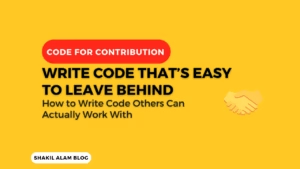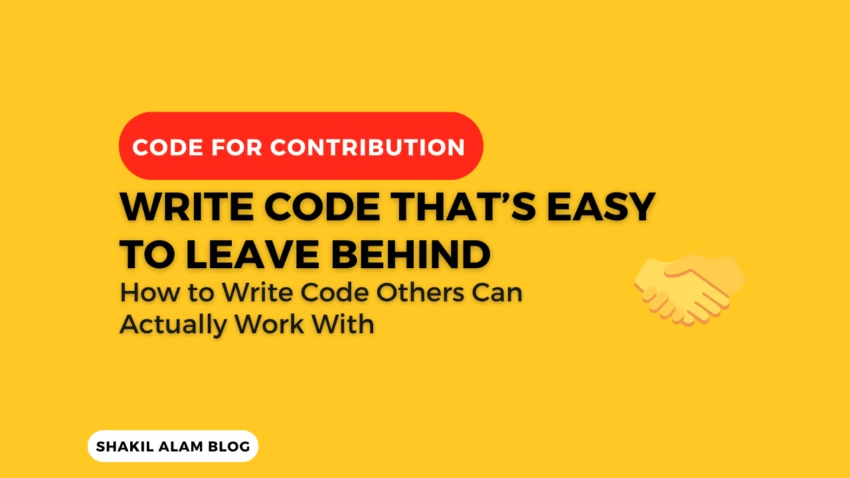Coding Alone Is Easy — Working With Others Is the Real Test
You ever joined a project and felt like the previous devs wanted to keep all the secrets to themselves? Like you opened a file and it practically whispered, “Good luck, buddy”? Yeah, we’ve all been there.
Here’s the thing: Code isn’t just about getting things to run. It’s about getting other humans to understand, use, and extend what you wrote. That’s the real skill. So if you want others to contribute to your code (or even yourself six months from now), you need to code like a teammate, not a lone wolf.

If you’re working in open-source, freelancing with teams, or hoping to scale your side project—your ability to write contributor-ready code determines how fast others can ship, fix, or build on top of your work. It’s not just about being good—it’s about being collaboratable.
Let’s break it down. No fluff. No buzzwords. Just hard-earned advice.
1. The Hidden Cost of “Works on My Machine” Code
The Problem: Code that works but makes zero sense to anyone else is a time bomb. Developers waste hours trying to figure it out or worse—they avoid touching it entirely.
The Fix: Code like you’re writing a manual for someone smart, but unfamiliar. Don’t be clever; be clear.
The Payoff: When others get your code, they’re less likely to break it and more likely to build on it.
Quick test: Can someone understand what your function does just by reading it and its name? If not, rename or refactor it.
✅ Reality Check: If your function names sound clever but require a doc comment every time, you’re doing it wrong.
2. Disorganized Projects = Disengaged Contributors
The Problem: Ever opened a project and thought, “Where the hell does anything go?” Random file names, God folders, or worse: one app.js doing everything. Chaos.
The Fix:
- Use folders logically (
components/,utils/,pages/, etc.). - Keep files small. Let them do one thing well.
- Name files after what they contain:
AddUserForm.tsx, notthingy1.js.
The Payoff:
- No guessing where things live.
- Contributors can add/edit features without pinging you every 10 minutes.
Note: Don’t over-engineer folder structures upfront. Let them grow organically but with intention.
3. Ignoring Guidelines Breaks Team Flow
The Problem: Tabs vs spaces. Snake_case vs camelCase. Every file feels like it was written by a different developer on a different planet.
The Fix:
- Use tools like ESLint and Prettier. Set them up once, forget them forever.
- Follow naming patterns already in place. Don’t be a rebel without a cause.
The Payoff:
- Clean diffs. Faster code reviews. Less nitpicking.
Bonus: Consistent code looks maintained, even when it isn’t.
And here’s the deeper reason:
If you don’t follow shared guidelines, others literally can’t help you. For example, if you’re using an ancient framework version no one supports anymore—or a PHP version that has no modern extensions left—good luck finding contributors. You’ve unintentionally locked the project to yourself.
When people see custom folder structures, obscure logic, or outdated tech without documentation, they’ll walk away. Not because they’re lazy, but because it’s a black box with a time cost.
Coding without guidelines is like building IKEA furniture without the manual, using parts from a different set. No one wants to clean that up.
A quick story to bring this home:
I once joined a freelance project that used a Laravel version from 2015. No Docker, no composer version lock, and half the vendor extensions were deprecated. They even hardcoded MySQL connections in the controllers. And worse, the previous devs had implemented their own half-baked templating system on top of Blade. I spent three days just trying to run migrations. You know how many issues I solved? Zero.
In the end, I had to walk away—not because I couldn’t code, but because their decisions made it impossible for anyone to help.
So yeah, guidelines aren’t just about code style. They’re about survival.
👥 Onboarding Made Easy
Good guidelines aren’t just for aesthetics—they help onboard new devs faster. Imagine someone joins your project and commits on Day 1 because everything’s predictable. That’s not magic. That’s structure.
If you want to improve your developer onboarding experience, start by enforcing consistency. It’s the fastest way to turn confused newcomers into confident contributors.
4. “Temporary” Code Is Forever Until Someone Cries
The Problem: That one TODO you left in 2021? Still there. And that random hack with no comment? It’s now blocking a major feature.
The Fix:
- Leave a reason, not just a TODO. Reference tickets or links.
- Clean up what you can. Don’t ship trash, assuming someone else will take it out.
The Payoff:
- Makes debugging bearable.
- Your future teammates (and future you) will silently thank you.
Rule of thumb: If it feels hacky, document the hack and why it exists.
5. Code Without Context Is Just Noise
The Problem: A function named handle() in a file named main.js does… what exactly? Code without context is like IKEA instructions without the pictures.
The Fix:
- Comments should answer why, not what.
- Use real names.
calculateDiscount()>cd(). This isn’t a coding competition.
The Payoff:
- Peers make safer edits.
- Fewer Slack messages asking, “Hey, what does this do?”
6. Clever Code Kills Collaboration
The Problem: You saved three lines with a one-liner, but now no one (including you) understands it a month later. Congrats, you wrote a riddle.
The Fix:
- Be boring. Be explicit.
- Break complex logic into clearly named functions.
The Payoff:
- Debugging is faster.
- Everyone feels confident editing their code.
If you have to explain your code in a meeting, it’s not self-explanatory enough.
7. README: Your Project’s Front Door
The Problem: New contributors clone the repo and then… stare at it.
The Fix:
A solid README should include:
- What this project does
- How to run it
- Where things live (basic folder structure)
- How to test, lint, and build
The Payoff:
- Reduces questions.
- Gets new folks contributing faster.
Think of your README like your project’s “Welcome, here’s the tour” guide.
Bonus: Include setup videos or GIFs in your README. Even a 30-second Loom walkthrough makes your project feel 10x more welcoming.
8. Git Like a Team Player
The Problem: Your commit history is 40 lines of “update”, “final fix”, “plz work”. It helps no one.
The Fix:
- Use meaningful commit messages:
fix(login): redirect expired tokens - Squash noisy commits when possible.
The Payoff:
- Easier to understand the project’s history.
- Debugging regressions becomes a breeze.
Pro tip: Use
git logoften to read your own story. If it doesn’t make sense, fix your commit habits.
9. Build for Extension, Not Just Execution
The Problem: Code is written for today’s needs. Tomorrow it breaks under pressure.
The Fix:
- Keep logic modular.
- Don’t hardcode values you might need to change.
- Write with reuse in mind (even if reuse isn’t needed yet).
The Payoff:
- Adding features gets easier.
- Other devs don’t need to rip apart your logic to extend it.
10. Reality Check: Could Someone Continue This Project Without You?
The Problem: You’re the only person who understands the core logic. If you disappear, so does progress.
The Fix:
- Share knowledge. Document tricky flows.
- Keep pull requests clean and scoped.
- Write code that doesn’t need you to explain it.
The Payoff:
- You become a better teammate.
- Your project becomes sustainable.
Truth: If no one can work without you, you’re not irreplaceable—you’re a bottleneck.
⚠️ Reminder: If your codebase only makes sense after a 2-hour Zoom call, you’re doing future you (and others) dirty.
Conclusion: Write Code That’s Easy to Leave Behind
Great code isn’t just about performance or elegance. It’s about being understood.
When you write code that welcomes others in, you:
- Make your project future-proof
- Enable real collaboration
- Become the kind of dev others want to work with
So, next time you push code, ask yourself: If I disappeared tomorrow, could someone else carry this forward?
If the answer is yes, congrats. You’re coding like a true contributor.
✅ TL;DR: How to Make Your Code Contributor-Friendly
- Be clear, not clever.
- Organize your files like a pro.
- Follow the damn guidelines.
- TODOs without context are time bombs.
- Name things like you care.
- Keep the README beginner-proof.
- Use commits that tell a story.
- Design for change, not just today.
- Document what only you know.
- Always code like you won’t be around tomorrow.
